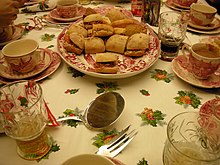Merienda




Merienda is a light meal[1] in southern Europe, particularly Spain, Portugal (merenda) and Italy (merenda), as well as Hispanic America, the Philippines, North Africa (Morocco) and Brazil (lanche or merenda). Usually taken in the afternoon or for brunch, it fills in the meal gap between the noontime meal and the evening meal, being the equivalent of afternoon tea in the English-speaking world; or between breakfast and lunch. It is a simple meal that often consists of a piece of fruit, cookies, yogurt, and other snacks paired with juice, milk, hot chocolate, coffee, spirits, or other beverages.
It is typical for Argentines and Uruguayans to have merienda around 5pm, between the midday meal and supper. It generally consists of an infusion (tea, mate, coffee, mate cocido, etc.) and a baked snack (scones, bread, toasts, cake, facturas, etc.), usually accompanied with dulce de leche, honey, butter or jam.
In the Philippines, merienda (Filipino: meryenda) is a generic term encompassing two light meals: the first is a morning snack that may correspond to either brunch, elevenses, or second breakfast; the second one is the equivalent of afternoon tea.[2] Merienda taken in the early evening around sunset just before or in place of dinner is meanwhile distinctly referred to as merienda cena.[3] Broadly, merienda is any sort of dish or snack in a portion smaller than the traditional "full meal" consisting of rice and a complementary viand (unless the merienda is taken as brunch or merienda cena), coupled with either a cool or hot drink (usually coffee). Common fare may be sweet or savoury, ranging from breads and pastries (notably pandesal), desserts and sweets, street food, to noodle dishes.[4]
In coastal parts of Croatia, Slovenia, and on the Greek island of Corfu,[5] it is referred to marenda, a meal eaten between breakfast and lunch.[6] Usually it is a light snack, like sandwiches or toast, eaten during a work break.
Goûter[]
In France, the merienda is called goûter or quatre-heures; the latter name refers to its timing at around 4PM. The modern goûter is lighter than a full meal, and is more often observed by children than by adults. It was a full cold meal until the 18th century, before which the goûter was taken at around 5PM, but began to fade in popularity thereafter, since the evening meal was pushed up to around 6PM.[7]
Podwieczorek[]
In Poland, the merienda is called podwieczorek or jużyna. It's a meal eaten in the late afternoon, "in the evening". Fills the break between lunch and dinner. Typically, light snacks are eaten, such as ice cream, fruit, cookies, chips, and fruit juice or hot drinks. Afternoon tea is eaten between 14.30 and 18.00. Podwieczorek in everyday life is eaten rather sporadically, and if it does not deviate from the second breakfast, consisting of bread with butter and jam and tea. On Sundays and holidays, however, afternoon tea is something common, providing an opportunity to socialize with sweet, mostly yeast bread, which is sipped with coffee or tea. In the Wielkopolska cuisine, a certain peculiarity is a potato pancake, known as a bambrzak, once consumed for an afternoon snack.
See also[]
References[]
- ^ Solomon H. Katz. (ed.). "Spain. Encyclopedia of Food & Culture". Vol. 2. Gale Cengage, 2003; http://www.enotes.com, 2006. Retrieved 27 December 2010.
- ^ "Merienda in the Philippines". Live in the Philippines. July 3, 2009. Archived from the original on 9 June 2010. Retrieved 27 December 2010.
- ^ Doreen G. Fernandez. "Filipino Food/Cuisine Glossary". Palayok: Philippine Food Time, On Site, in the Pot. Manila: Bookmark Inc., 2000; Center for Southeast Asian Studies, Northern Illinois University. Retrieved 27 December 2010.
- ^ Child, Julia; Greenspan, Dorothy (4 November 1996). Baking with Julia: Sift, Knead, Flute, Flour, and Savor... William Morrow Cookbooks. ISBN 9780688146573.
- ^ Chatto, James; Wendy L., Martin (1998). A Kitchen in Corfu. New Amsterdam Books. p. 20.
- ^ "Pleasures of the palate and beverages to quench your thirst". How to survive in and even enjoy Croatia, A guide for smart foreigners. Retrieved 27 December 2010.
- ^ Hamlyn (2018). New Larousse Gastronomique. Octopus Books. p. 1473.
- Argentine cuisine
- Brazilian cuisine
- Latin American cuisine
- Philippine cuisine
- Moroccan cuisine
- French cuisine
- Spanish cuisine
- Portuguese cuisine
- Andorran cuisine
- Italian cuisine
- Greek cuisine
- Croatian cuisine
- Serbian cuisine
- Slovenian cuisine
- Polish cuisine
- Meals